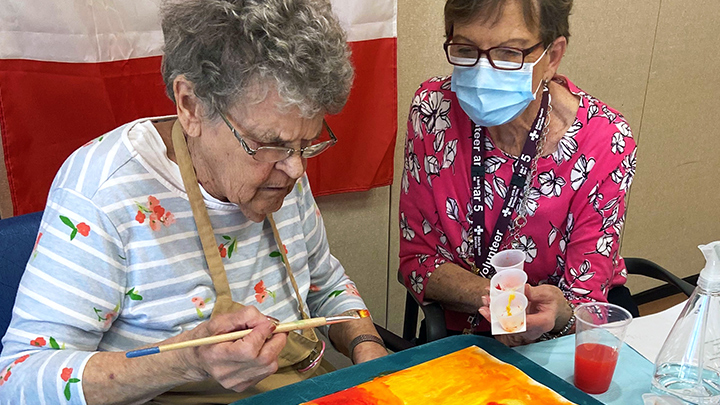
October 19, 2022

Vivian, left, works her creative magic on a piece of art, which she later entitled: You Better Start Running. Her newfound friend and fellow participant Rosalie watches on during the Opening Minds through Art session at the Drumheller Health Centre. Photo supplied.
Story by Yolanda Genu
DRUMHELLER — People living with dementia enjoyed the first Opening Minds through Art (OMA) program at the Drumheller Health Centre.
With the support of dedicated volunteers, six clients from the continuing care centre and five people from the community expressed themselves by creating art and connecting with others in the summer program, led by Rachel Graf, a recreation therapy assistant and an OMA-trained facilitator.
OMA is an award-winning and evidence-based program that provides opportunities for creative self-expression and social engagement. It was founded in 2007 by Dr. Elizabeth Lokon to enable people living with dementia enjoy new artistic roles.
“There’s a great stigma around this disease that needs to be broken,” says Graf. “OMA helps those living with dementia and Alzheimer’s to open up and regain their sense of purpose and independence. Because clients were free to create artwork that spoke to them, they felt proud and accomplished. I saw them light up every time after seeing their completed art pieces.”
Vivian, a program participant, says: “I was shocked to see my paintings like this. I didn’t believe they were mine.”
Graf says she first heard about the program while she was still a recreation therapy gerontology student. As she learned more, she grew to understand why it’s important to help people who are living with different neurocognitive disorders. OMA allows them to create unique and wholesome art, while being in control of what they’re creating.
“Too often, decisions end up being created for those who are living with dementia and Alzheimer’s disease. So one of the biggest goals through this program is to give them the time, and patience, to be able to make their own decisions. OMA opened my eyes and showed me that (they) are not lost but simply misunderstood.”
Linda Krieger, Volunteer Resources coordinator, adds: “Volunteers who completed the OMA training provided one-to-one support to residents throughout the six-week program. This allowed the participants a failure-free opportunity for creative self-expression and social engagement.”
Rosalie, one of the volunteers, says: “Volunteering with Alberta Health Services has allowed me to participate in the OMA program, for which I’m truly grateful. Right from orientation with Rachel, which gave new insight into dementia, through to the end of the six-week program, it’s been an incredible journey.”
“Both the volunteers and the residents expressed so much joy during the program. Volunteers are excited to participate in upcoming sessions scheduled to take place in November.” adds Krieger.
At the end of six weeks, the clients, their families, caregivers, staff and loved ones attended an art show to celebrate their artistic accomplishments.
“The OMA program is a remarkable opportunity for our volunteers to support residents in sharing their voice through art,” says Erin Poissant, manager, Volunteer Resources and Spiritual Care.